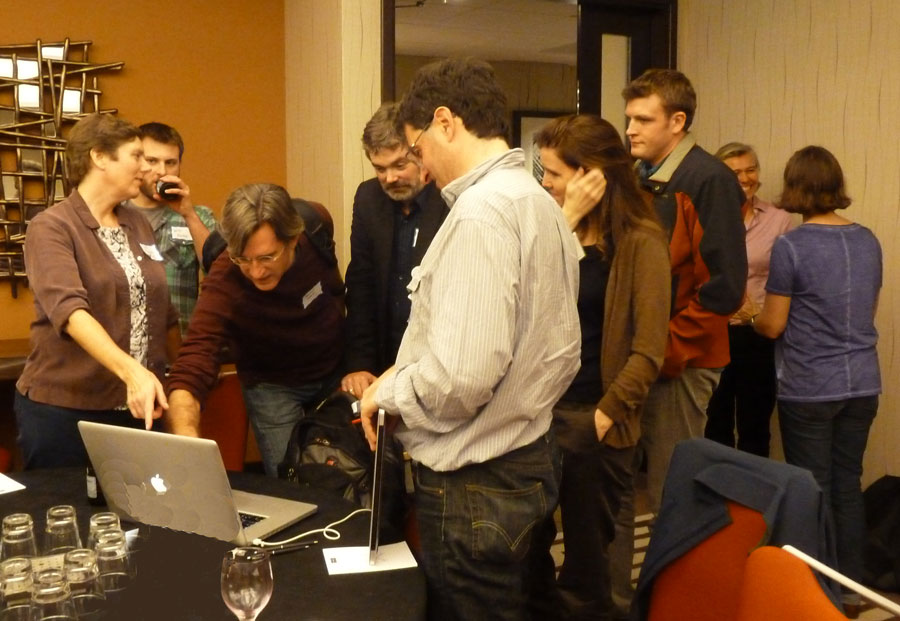Sunday, December 2, 2012, 6:00 – 9:30 pm
Conveners: W.Steve Holbrook, Geoff Abers, Maya Tolstoy, Suzanne Carbotte, Anne Trehu, Harold Tobin, Doug Toomey, Katie Keranen, Paul Johnson
6:00-7:30 | Major projects
- GeoPRISMS Goals – Juli Morgan
- NSF – proposal opportunities, Dear Colleague – Batiza, Blackman, Haq
- COAST Open Access project – Steve Holbrook
- Cascadia Amphibious Array
- OBS deployment update – Doug Toomey
- OBS noise characterization – Spahr Webb
- Onshore/offshore seismic integration – Geoff Abers
- OOI Geophysics – Will Wilcock
- Legacy seismic data – Anne Trehu
7:30-8:00 | Five-Minute Presentations
- Developing a comprehensive model of subduction and continental accretion at Cascadia – Haiying Gao
- Cascadia basin to trench – Suzanne Carbotte et al.
- Cascadia forearc faults = Increasing dextral sheer and N-S shortening to west -Katie Keranen
- GeoPRISMS, EarthScope, MG&G MT Stations in Cascadia – Adam Schultz
- Cascadia Ridge2Trench – to arch Washington transect – follows CAFE – Geoff Abers
- Cascadia Ridge2Trench – Ann Trehu
8:00-8:45 | Open Discussion
- OBS array redeployment
- Future MCS: 2D vs 3D
- Wide-angle, active-source seismics (OBS, onshore-offshore)
- Bathymetric grids
- Data Sharing
8:45-9:30 | Posters
This mini-workshop will focus on marine and “amphibious” geophysical activities in the Cascadia Primary Site; mini-workshop objectives will be to review progress, coordinate activities, and plan future work in Cascadia, particularly in association with the recent acquisition of several major new large-scale geophysical data sets. This mini-workshop will leverage the current momentum from the present marine geophysical studies in Cascadia and provide the underlying context for the next decade of interdisciplinary studies of the area.
The Cascadia subduction margin has been designated as a Primary Site for the GeoPRISMS program, due largely to the seismic hazard posed to the U.S. Pacific Northwest by potential megathrust earthquakes on the subducting plate boundary. Although science planning has begun with several successful workshops (Cascadia Initiative, October 2010; GeoPRISMS, April 2012), PI- and community-driven projects are in a nascent state. The past year has been particularly active for offshore Cascadia margin studies. Four separately funded seismic studies were conducted:
- The Cascadia Initiative OBS passive-source deployment,
- Two active-source Langseth surveys (Ridge2Trench and COAST)
- Onshore-offshore piggybacks to the two Langseth surveys.
- Review Cascadia science goals in the context of recent progress and new data
- Exchange information and preliminary results, both among current PI’s and more broadly to the community
- Coordinate joint interpretation of diverse geophysical data
- Publicize and encourage broad community use of open-access data sets
- Stimulate discussions on future work and proposals

Marine Geophysics in the Cascadia Primary Site | AGU 2012
Marine Geophysics in the Cascadia Primary Site
Convened by: W.Steve Holbrook, Geoff Abers, Maya Tolstoy, Suzanne Carbotte, Anne Trehu, Harold Tobin, Doug Toomey, Katie Keranen, Paul Johnson
This mini-workshop, held on Sunday December 2, 2012, focused on recent marine and “amphibious” geophysical activities in the Cascadia Primary Site. Projects (and presentations) include:
- Cascadia Initiative OBS Passive-Source Deployment & data (Doug Toomey & Spahr Webb)
- COAST Open Access Marine Seismic Project (Steve Holbrook)
- Ridge2Trench Marine Seismic Project (Suzanne Carbotte)
- Onshore-offshore Integration of Seismic Data Sets (Geoff Abers)
- Review of Legacy Seismic Data in Cascadia (Anne Trehu)
- In addition, several contributions from the floor reviewd related projects, including
- Models of subduction and continental accretion in Cascadia (Haiying Gao)
- Cascadia forearc faults (Katie Keranen)
- Review of magnetotelluric studies in Cascadia (Adam Schultz)
- OOI geophysics (Will Wilcock)
The mini-workshop allowed the community to review progress, coordinate activities, and plan future work in Cascadia, leveraging the current momentum from the present marine geophysical studies in Cascadia, and providing the underlying context for the next decade of interdisciplinary studies of the area.
